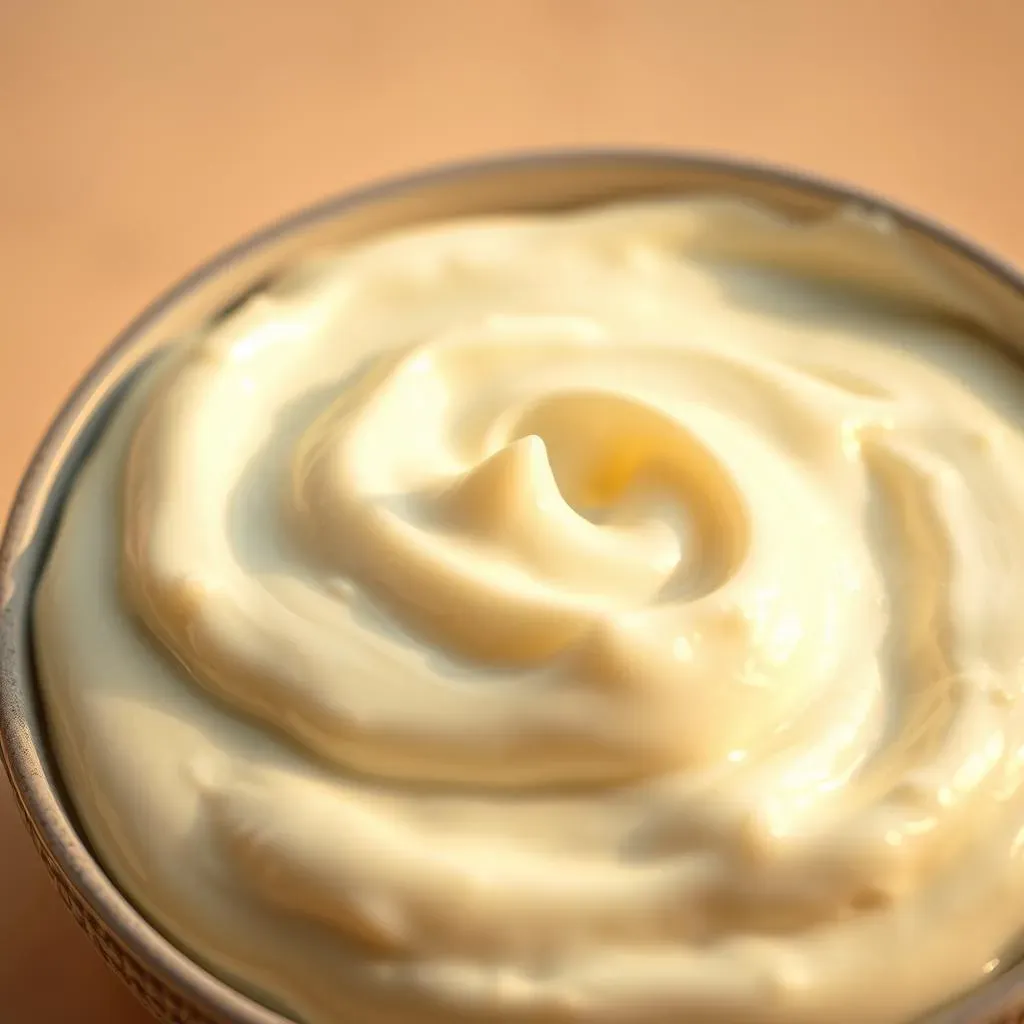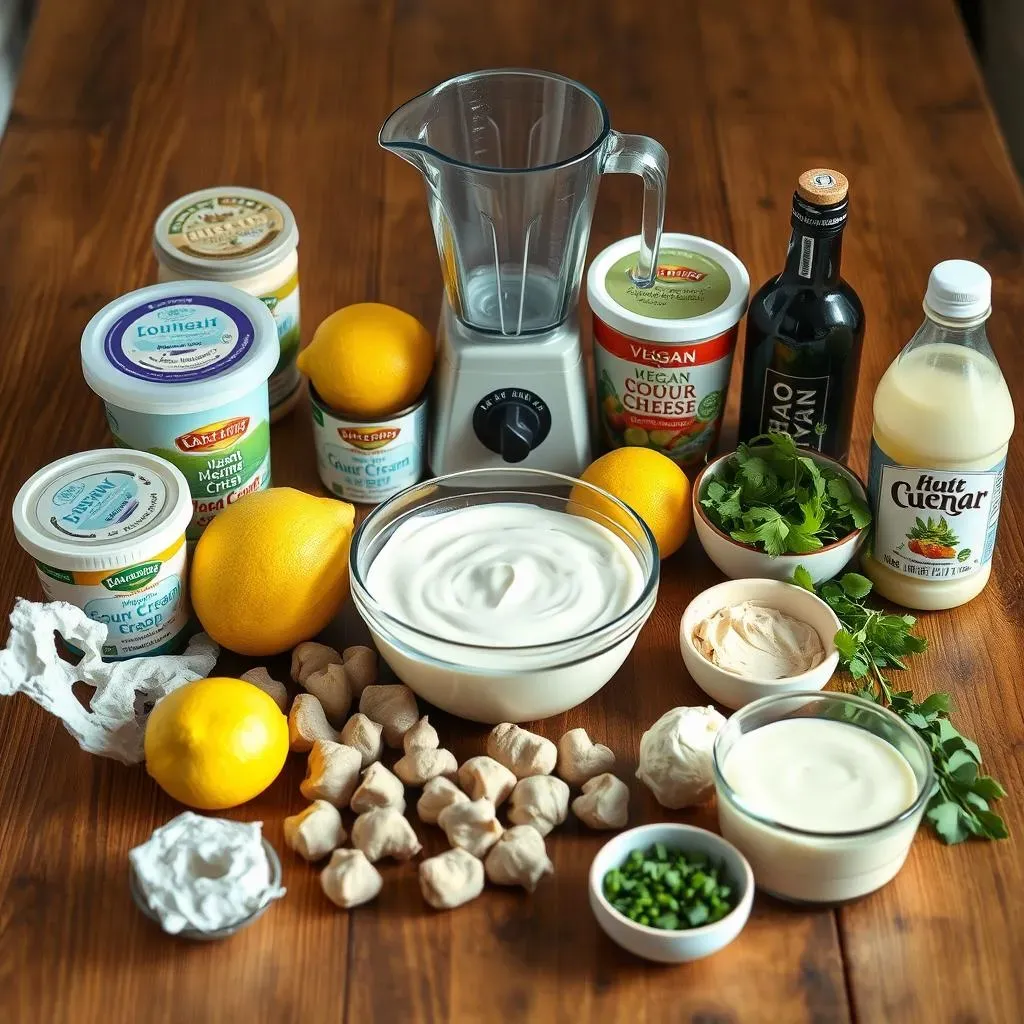Table of Contents
Ever stared into your fridge, recipe in hand, only to realize you're out of sour cream? It's a common kitchen calamity, but don't fret! The good news is that you might have a fantastic substitute lurking in the dairy section: Greek yogurt. But, is greek yogurt a good substitute for sour cream? That's the question we're tackling today. We'll explore what makes sour cream unique – that tangy, rich goodness that we all love. Then, we'll get into how Greek yogurt stacks up, looking at its texture, taste, and how it behaves in different recipes. Beyond Greek yogurt, we'll uncover other dairy and even some non-dairy options you can use in a pinch. This article is your guide to understanding sour cream substitutes, ensuring you're never stuck mid-recipe again, and confident that you know the best options for each use case.
What Makes Sour Cream, Sour Cream?

What Makes Sour Cream, Sour Cream?
Okay, so before we get into swapping sour cream for other stuff, let's talk about what makes it, well, *sour cream*. It's not just cream that's gone bad, I promise! It's actually a fermented dairy product, which means it's made by adding special bacteria to cream. These little guys eat the lactose (that's the sugar in milk), and they produce lactic acid, which gives sour cream its signature tang. This process also thickens the cream, making it smooth and, you know, creamy. The fat content is also a key player here, giving it that rich texture we all love. It's why it's so good in things like dips, sauces, and baked goods. So, it's not just about being sour; it's a whole combination of things that makes it what it is.
Greek Yogurt: A Solid Sour Cream Substitute

Greek Yogurt: A Solid Sour Cream Substitute
The Texture and Tang
Okay, so you're thinking about swapping sour cream for Greek yogurt. Good call! It's actually a pretty smart move. Greek yogurt has this wonderfully thick and creamy texture, which is a lot like sour cream. The key difference is that Greek yogurt is strained more, getting rid of extra whey, making it thicker and richer than regular yogurt. This means it can often stand in for sour cream without making your recipes too runny. Also, it's got that tangy flavor, thanks to the fermentation process, which is similar to the sour taste of sour cream. It's not exactly the same, but it's close enough that in most cases, you won't even notice the difference.
Now, I know what you might be thinking: "Will it taste exactly the same?" No, not exactly. Greek yogurt tends to be a bit more tart than sour cream, but this can actually be a good thing. It adds a nice zing to dishes. In some cases, it might be a bit too much, so I'd suggest starting with a 1:1 ratio when substituting, and then adjusting to your taste. If you find the tang is a bit strong, try adding a tiny bit of milk or a pinch of sugar to mellow it out. It's all about experimenting and finding what works best for your taste buds.
When to Use Greek Yogurt
So, when can you confidently use Greek yogurt instead of sour cream? Well, it's a real workhorse in the kitchen. It's great in dips, like your classic onion dip or a spicy salsa. It adds that creamy base without being too heavy. I use it all the time in salad dressings for a healthier twist - it makes them super creamy without all the fat of sour cream. And for baking? Absolutely! It works wonders in cakes and muffins, adding moisture and a bit of tang. I even use it as a topping for tacos or baked potatoes, just like sour cream. It’s a versatile sub and a great way to sneak in some extra protein, too.
There are a few times when you might need to be a bit careful. If you're making something where the sour cream is the star of the show, like a stroganoff, you might notice a slight difference in flavor. In those cases, you can try using full-fat Greek yogurt, which will be closer to the richness of sour cream. Also, if a recipe relies heavily on the fat content of sour cream for its texture, like some creamy sauces, you might need to add a little extra fat, like a touch of olive oil or butter, to achieve the same result. But for most everyday cooking and baking, Greek yogurt is a fantastic and healthy swap.
Use | Greek Yogurt as Substitute | Notes |
|---|---|---|
Dips | Excellent | Adds creaminess and tang, adjust seasoning |
Dressings | Great | Lighter than sour cream, add a touch of fat if needed |
Baking | Good | Adds moisture and tang, may need slight adjustments |
Toppings | Perfect | Use 1:1 ratio, adjust taste |
Other Dairy Substitutes for Sour Cream

Other Dairy Substitutes for Sour Cream
Alright, so maybe you're not feeling the Greek yogurt today, or perhaps you're just curious about what else is out there. Good news, the dairy aisle is packed with other options that can step in for sour cream. First up, we've got plain yogurt. It's a pretty straightforward substitute, but it's not quite as thick as Greek yogurt or sour cream. It will work in a pinch, but you might want to drain some of the liquid off to thicken it up a bit, especially if you're using it in a dip or as a topping. Then there's crème fraîche, it's like sour cream's richer, more sophisticated cousin. It's got a higher fat content, which gives it a super creamy texture. It's great for sauces and soups, where you want a luxurious feel.
Don't forget about Mexican crema, which is similar to crème fraîche but a bit tangier. It works well in Mexican dishes, obviously, but is also great in other applications too. We can also consider buttermilk, it's thinner than sour cream, but it has that signature tang. It's fantastic for baking, making cakes and muffins extra moist and delicious. And for the adventurous, there's kefir, a fermented milk drink that's packed with probiotics. It’s tangier than sour cream and thinner, but it can add a unique flavor to dressings and marinades. Even certain types of cheeses, like ricotta or cottage cheese (blended smooth), can be used in a pinch, especially in baked goods. Each one has its own personality, so it's all about choosing what best fits the dish you're making.
Substitute | Texture | Flavor | Best Uses |
|---|---|---|---|
Plain Yogurt | Thinner | Tangy | Dips, toppings, baking (with adjustments) |
Crème Fraîche | Rich, thick | Mildly tangy | Sauces, soups, baking |
Crema Mexicana | Thick | Tangy | Mexican dishes, toppings |
Buttermilk | Thin | Tangy | Baking, marinades |
Kefir | Thin | Very Tangy | Dressings, marinades |
Ricotta/Cottage Cheese | Variable, can be smooth | Mild | Baking, sauces (blended) |
Nondairy Options When Sour Cream Isn't Around

Nondairy Options When Sour Cream Isn't Around
Cashew Cream Magic
Okay, so what if you're not into dairy at all? No problem! The world of non-dairy sour cream substitutes is actually quite exciting. Let's start with cashew cream. It's made by soaking raw cashews and then blending them with water and a bit of lemon juice for that tang. It's super creamy and rich, making it a fantastic substitute in dips, sauces, and even baking. Seriously, you'd be amazed how well it mimics the texture of sour cream. The magic is in the blending – you need a high-powered blender to get it really smooth.
I've used cashew cream in everything from vegan enchiladas to creamy pasta sauces, and it works like a charm. It's a bit more work than just grabbing a container of yogurt, but the results are totally worth it, especially if you're catering to non-dairy folks. And the best part? It's really versatile. You can adjust the thickness by adding more or less water, and you can tweak the flavor with a bit of salt, garlic, or herbs.
Store-Bought Wonders and Mayonnaise
If making cashew cream feels like too much effort, don't worry, there are plenty of store-bought options available. Vegan sour cream and cream cheese are becoming increasingly common, and they're pretty good stand-ins. They're usually made from a blend of plant-based ingredients like soy, coconut, or nuts, and they do a pretty solid job of replicating that tangy flavor and creamy texture. I've noticed that some brands are better than others, so it's worth trying a few out to find your favorite. A little tip: read the labels carefully, some can be surprisingly high in fat and sodium.
And then there's the slightly unconventional choice: mayonnaise. Hear me out! Mayonnaise is made with eggs and oil, so it's definitely not dairy-free, but it can work in some applications where you need that creamy texture, like in dips or dressings. It doesn't have the tang of sour cream, so you might need to add a bit of lemon juice or vinegar to get that flavor. I know it sounds a bit out there, but it's a good option if you're in a pinch and don't have any other alternatives on hand.
Substitute | Base | Texture | Flavor | Best Uses |
|---|---|---|---|---|
Cashew Cream | Cashews | Very Creamy | Tangy | Dips, sauces, baking |
Vegan Sour Cream | Various Plant-Based | Creamy | Tangy | Versatile |
Mayonnaise | Eggs & Oil | Creamy | Mild (add tang) | Dips, dressings |
Important Things to Consider
Before you go wild swapping out sour cream with any of these options, there are a few things to keep in mind. First, the fat content. Sour cream is quite high in fat, which contributes to its richness and texture. If you're using a lower-fat substitute, like some vegan options, you might need to add a bit of extra fat to achieve the same result, especially in baking. Second, the tang. Some substitutes, like cashew cream, might need a little extra lemon juice or vinegar to get that sour flavor. And lastly, always taste as you go. The best way to ensure a successful substitution is to adjust the recipe to your taste. Remember, cooking is an adventure, not a science experiment, so don't be afraid to experiment and have fun with it!